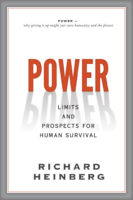 This is an abridged excerpt from Power: Limits and Prospects for Human Survival (2021) by Richard Heinberg; posted with permission from New Society Publishers.
This is an abridged excerpt from Power: Limits and Prospects for Human Survival (2021) by Richard Heinberg; posted with permission from New Society Publishers.
We often think of the downside of power just in terms of its abuses—people using power with evil intent. There are many ways of abusing power, and the fields of clinical psychology, political science, and law are largely concerned with understanding and remedying abuses of social power. However, in this chapter I will focus primarily on power dilemmas that are less frequently discussed, but that may be even more important for us to understand, especially in the 21st century: problems that occur when sheer amounts of physical power overwhelm natural systems, and when concentrated vertical social power threatens individual and collective human well-being.
The problems of the abuse of power and of over-empowerment are not mutually exclusive. Indeed, especially in complex societies, over-empowerment often encourages the abuse of power. But the dilemma of too much power is not confined to the social arena, and may be easier to understand, at least in principle, by way of a few examples that have little to do with human relations.
Electrical engineers are well acquainted with the problem of too much power. An electrical power overload—in which electricity flows through wires that are too small to handle the current—can cause a fire. Similarly, physicists know that, while fuels and batteries store energy for useful purposes, when that energy is released too quickly an explosion can result.
Earth is constantly bathed in 174 petawatts of power from the sun (a petawatt is one quadrillion watts). That solar power drives weather and life on our planet; everything beautiful and pleasant in our lives traces back to it. But sometimes this power moves through Earth’s systems in a destructive surge. Storms cause the quick release of enormous amounts of energy. The wildfires in Sonoma County, California, where I live, can burn with many gigawatts of power. A gigawatt of electrical power that’s controlled via power lines, transformers, and circuits can supply light, heat, and internet connections to a small-to-medium-sized city. A gigawatt of radiative power unleashed in a firestorm can torch that same community in just a few hours.
The same essential principle holds with social power. Cooperation, the basis of social power, gives us the means to accomplish wonders. But social power, channeled through elaborate economic systems featuring various forms of debt and investment, can also enable the pooling of immense amounts of wealth in just a few hands, resulting in needless widespread poverty and eventual civil unrest. That same social power, released in a sudden burst, can lead to the deaths of millions of people through war or genocide.
In this chapter I will summon evidence to make the case that we humans have, in many instances, amassed too much physical power and vertical social power for our own good, and that we are overpowering natural systems and social systems with that power, creating conditions potentially leading to unnecessary human mortality and suffering, as well as ecological disaster, on a massive scale.
Power is essential; without it, we would be literally powerless. But one can have too much of a good thing. How much power is enough? How much is too much?
The best way to judge how much power is too much is by assessing the consequences of its usage, taking care to untangle (as much as possible) issues caused by abuse of power from those resulting simply from the concentration or proliferation of too much of it. Here’s a telling example: our ability to control fire has done us immense good over the millennia. But today nearly everything we do is associated with a little fire somewhere, perhaps in a factory or a power plant or the engine of our car. Engineers have taken great care, over the past few decades, to increase the efficiency of engines and furnaces, especially in the industrialized countries that do most of the burning. But each of those fires still inevitably emits carbon dioxide, and all these billions of fires added together are giving off enough CO2 to imperil life on the planet. Fire is good; but too much fire, even intelligently controlled fire, can be very, very bad. (I’ll discuss climate change in more depth below.)
We are about to survey evidence that humanity as a whole is over-empowered, evidence that consists of harmful consequences already unfolding. To make a logically consistent case, I will show that these consequences are not merely random bad things happening. Difficulties, even tragedies, are inevitable parts of life; and war, famine, and inequality have long histories. I will show what’s different today, focusing on impacts that are of a scale far larger than those occurring previously, that could result in severe injury for massive numbers of humans and in some cases the entire biosphere, and that are clearly traceable to humanity’s recently enhanced powers. In addition, in each section below, we will see why solutions to our deepening problems cannot be achieved just by exposing and ending abuses of power, but are instead necessarily contingent on a reduction, or reining in, of specific human powers.
Sidebar: Rising Risk of Disease and Pandemic
As of this writing, the novel coronavirus pandemic that began in early 2020 is still raging across the planet. For many years, public health experts had warned that a serious epidemic was increasingly likely to emerge, and to quickly become global, as a result of encroachment of civilization into wild habitat and rapid global transportation.
SARS-CoV-2 has proven to be highly infectious, and also to have a case fatality rate far higher than that of most yearly influenza viruses. Without dramatic measures to slow the coronavirus’s spread, many millions would likely have died in the first year. Nations did undertake dramatic lockdown measures to suppress infection rates, so that their healthcare systems would not be overwhelmed, and to provide time for the discovery of treatment regimens and the development of vaccines. These lockdown measures succeeded in slowing the infections and deaths, but had a catastrophic impact on the global economy.
Epidemiologists warn that future virus pandemics could be even more lethal. Most novel diseases arise through contact between humans and non-human animals. As civilization expands ever further into formerly wild regions, more new contacts between humans and reservoirs of formerly isolated disease organisms will occur. This is just one of the ways that destruction of habitat for other creatures boomerangs to reduce human well-being.
This is an abridged excerpt from Power: Limits and Prospects for Human Survival (2021) by Richard Heinberg; posted with permission from New Society Publishers.
Photo by Elisabeth Arnold on Unsplash






